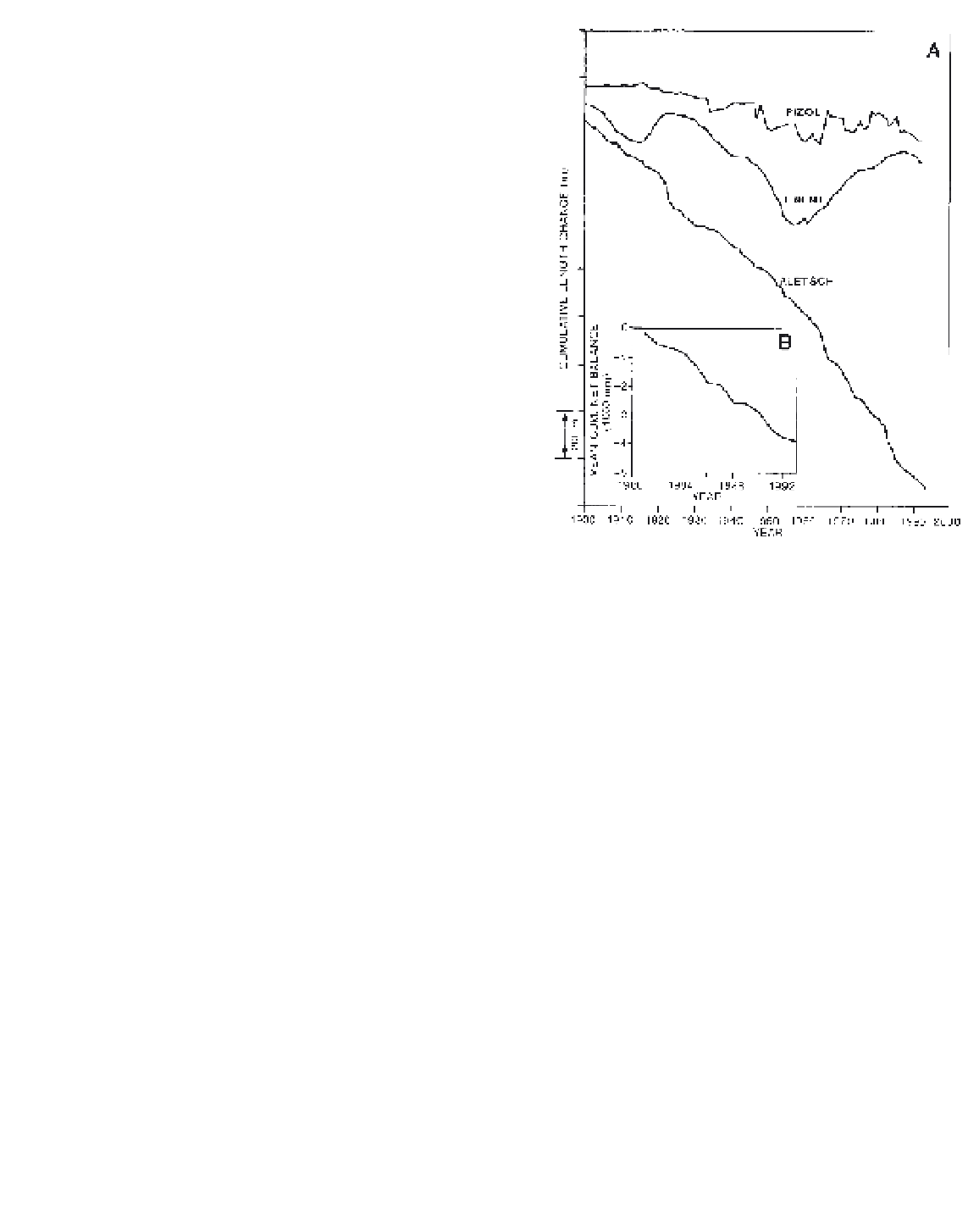Geoscience Reference
In-Depth Information
2 Snow and ice
The effects of twentieth-century climate change on
global snow and ice cover are apparent in many ways,
but the responses differ widely as a result of the different
factors and timescales involved. Snow cover is essen-
tially seasonal, related to storm system precipitation
and temperature levels. Sea ice is also seasonal around
much of the Antarctic continent and in the marginal
seas of the Arctic Ocean (see Figure 10.35A), but
the central Arctic has thick multi-year ice. Seasonal
(or first-year) ice grows and decays in response to ocean
surface temperature, radiation balance, snowfall and ice
motion due to winds and currents. The loss of multi-
year ice from the Arctic is mainly through ice export.
Glacier ice builds up from the net balance of snow
accumulation and summer melt (ablation), but glacier
flow transports ice towards the terminus, where it may
melt or calve into water. In small glaciers, the ice
may have a residence time of tens or hundreds of years,
but in ice-caps and ice sheets this increases to 10
3
to 10
6
years.
In the twentieth century, there has been a rapid
retreat of most of the world's glaciers. Glaciers in
the North Atlantic area retreated during the 1920s to the
mid-1960s and since 1980, due largely to temperature
increases, which have the effect of lengthening the
ablation season with a corresponding raising of the
snowline. In the past ten or fifteen years the freezing
level in the troposphere has risen in the inner tropics by
100 to 150 m, contributing to rapid ice loss on equatorial
glaciers in East Africa and the northern Andes. Also
in the past decade or so, some glaciers in maritime
climates (western North America and Scandinavia)
have shown advances, due to heavier snowfalls during
warmer winters. Major alpine glaciers in many areas
of the world have lost mass and shrunk since the late
nineteenth century, whereas smaller ones show short-
term fluctuations in response to climatic variability
(Figure 13.24). There has been accelerated retreat in
some areas since the late 1970s, especially in Alaska
and central Asia. Projections for
AD
2050 suggest that
a quarter of the present glacier mass may disappear with
critical and irreversible long-term consequences for
water resources in alpine countries.
Another tendency illustrating world warming is the
retreat of Arctic sea ice. Ports in the Arctic remained
free of ice for longer periods during the 1920s to 1950s,
for example. This trend was reversed in the 1960s to
Figure 13.24
Trends in cumulative net mass balance for thirty-
five glaciers in eleven mountain ranges in North America, Europe
and Africa for 1980 to 1993 (B) and cumulative length changes
since 1900 of characteristic glacier types in the Swiss Alps (A). Pizol
is a cirque glacier; Trient is a medium-size mountain glacier; and
the Aletsch is a large valley glacier.
Source
: Haeberli (1995). Reproduced by permission of
Geografia Fisica
e Dinamica Quaternaria
.
1970s, but since 1978 the annual extent of Arctic ice has
decreased by almost 3 per cent per decade with large
reductions in summer, particularly in the Eurasian
Arctic in 1990, 1993 and 1995, north of Alaska in 1998
and in the central Arctic in 2001. Between the 1960s-
70s and early 1990s, ice in the central Arctic Ocean
thinned but the magnitude of this is uncertain due to
spatial and seasonal sampling limitations. The changes
may reflect a redistribution of the ice mass by shifts in
ocean and wind circulations.
There appears to have been a slight increase in
Antarctic ice extent, although comprehensive records
began only with all-weather satellite coverage in 1973.
Sea ice in both polar regions is expected to shrink and
thin with continued warming, but modelling of these
processes remains rudimentary.
Major iceberg calving events have occurred over the
past ten or fifteen years along the Ross Ice Shelf. The

